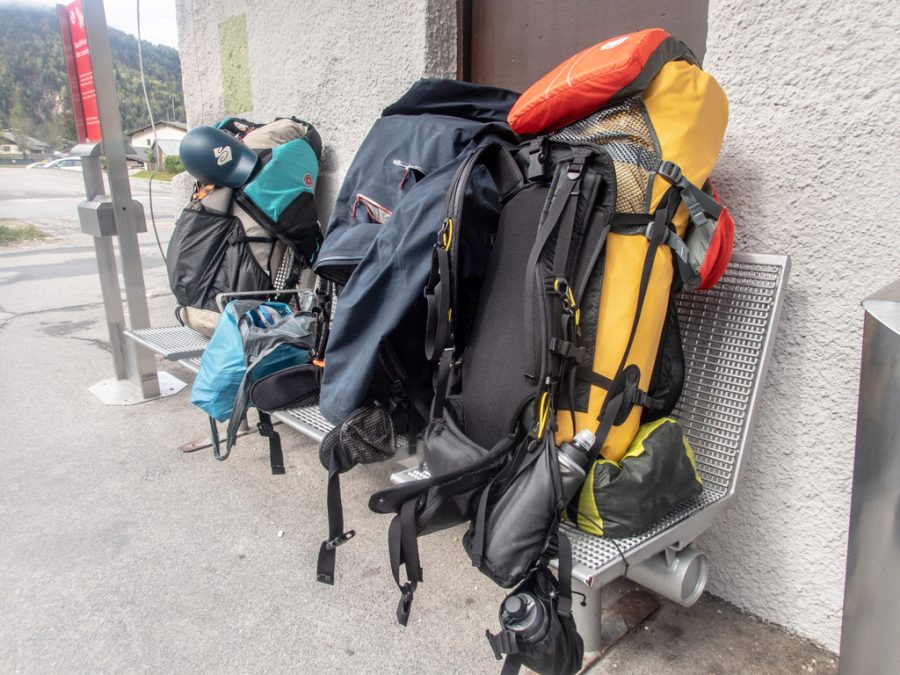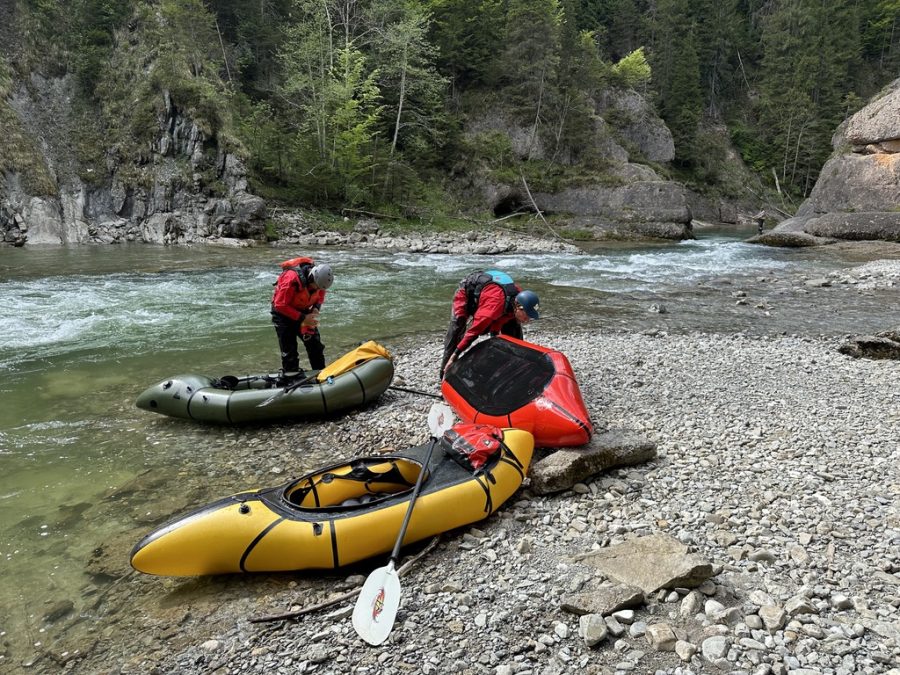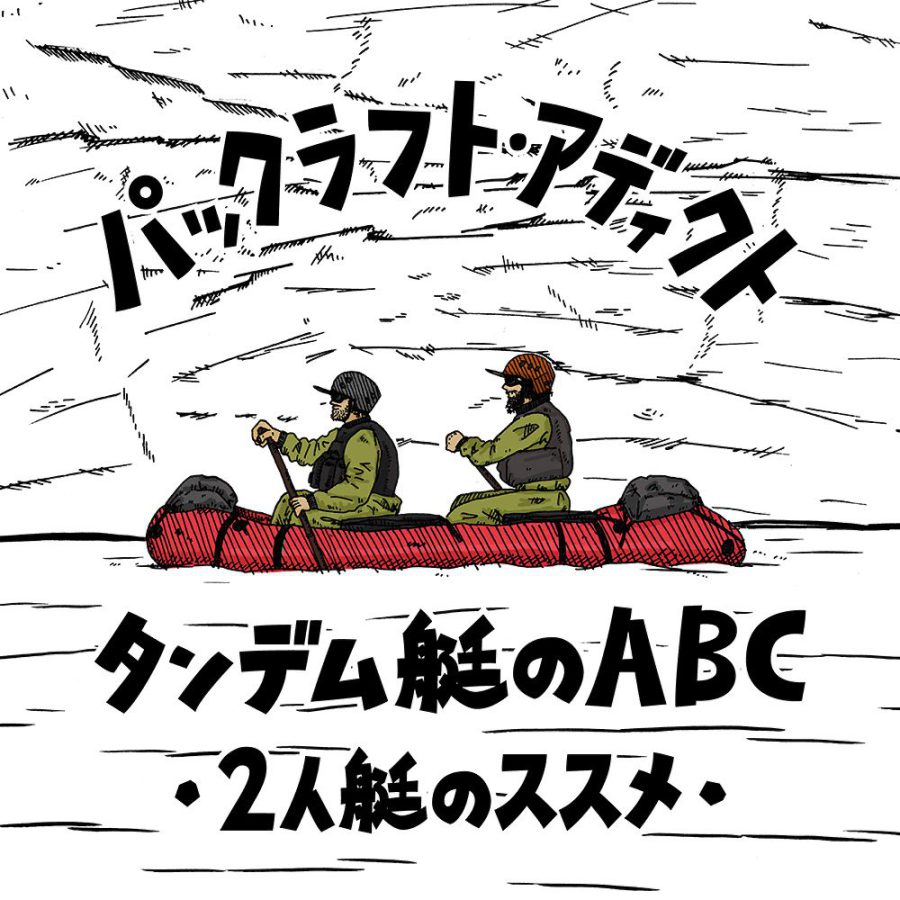中欧・イザール川 & アンマー川 アルプスでのハイキング&パックラフティング | パックラフト・アディクト #77

Packrafting Adventure on the Isar and Ammer Rivers

In the second week of May, during the long Ascension Day weekend, we embarked on a short, but exciting packrafting adventure that put the “pack” back into packrafting.

Unlike the trips that I have recently had, this one was completed entirely using trains, walking, and even some running – no cars involved. Our destination was the upper Isar in Austria and southern Germany, with the plan to enjoy a multi-day paddling experience amidst the stunning alpine scenery.

Originally, I was planning this trip together with Harold, who I know for a while (please see my previous articles), but we decided to invite Volker, a new packrafting friend of ours. Last year he attended the Scandinavian Meetup in Finland and was told about me by my Finnish friends. So, he contacted me on social media last summer, but we managed to meet each other for the first time only at the end of April, just three weeks before this trip, when we paddled another river in Germany.
Volker, a 51-year-old German with extensive paddling experience, had recently gotten into packrafting and was eager to join us. This was also very good as just days before our trip, Volker discovered that a significant portion of the Isar we intended to paddle was closed until June 1st. Therefore Harold, familiar with that area, suggested we include the Ammer in our itinerary. While Harold had paddled both rivers before, I had only paddled a middle section of the Isar (the very one that was still closed), and Volker had never paddled either.

We began our journey on Wednesday evening, when Harold and I took an overnight train from Utrecht, where we joined Volker who boarded it already in Amsterdam. As we waited for the train, we noticed a fellow traveller with snowshoes strapped to his backpack, a reminder that there was still plenty of snow in the Alps despite the warm weather back home. The overnight train experience was nostalgic, bringing back memories of previous travels both in Russia and in Europe. Even though we had the lower berths, there was very little space in our 6-person compartment. Still, equipped with earplugs, I slept soundly and awoke to a new day in Munich – the beauty of such a trip.

As we faced a slight delay, upon arrival in Munich, we were forced to rush to catch our next train, a reginal train this time. It was foggy and relatively cold – the information display on the train showed only 10°C. After changing the train in Garmisch-Partenkirchen, we travelled further south to the first train station in Austria, Scharnitz, which lies at 964 meters above sea level. From there, needed to hike up to the put in point not far from the source of the Isar.
As we had to walk a lot more this trip and, unfortunately, I had been suffering from a heel spur recently, we decided to try to save on the weight as much as possible and share whatever gear we could. Thus, I brought the cooking gear for the group, while Harold was responsible for the ‘accommodation’.

Having scouted a bigger rapid in Scharnitz, we and embarked on a 10.5 km hike to our put-in point. The hike was beautiful, with views of the river canyon, alpine flowers, a waterfall, and even a tiny avalanche that looked like a small waterfall. It was a scenic introduction to the adventure that awaited us. The sun came out and it became warm. We also saw a puddle next to the road filled with hundreds of salamanders, a fascinating sight I had never seen before.

The road itself was rather easy. It was a common route for bikers and hikers, a lot of whom we met on the way. And that was good as it turned out that I had forgotten to bring a lighter or matches, and neither Harold nor Volker had one either. (We discovered it at the put-in, when Harold joked about making a cup of tea). Fortunately, we managed to get one from a passerby who had a pair.

The Isar River, originating in the Karwendel range of the Austrian Alps, flows 295 kilometres through Tyrol and Bavaria, eventually joining the Danube. The river offered a mix of whitewater sections ranging from class I to III, though the conditions we encountered were closer to class I and II+ due to lower water levels. This made for a manageable yet thrilling experience as we paddled the river’s twists and turns.

We packrafted 5 km on the Isar that first day, navigating through a stunning canyon and spotting a chamois on a vertical cliff. That was not easy to do as they have a really good camouflage. However, some small stones falling into the river betrayed its position. The sight of the chamois, gracefully perched on the cliffside, was another highlight of the day and a testament to the wild beauty of the region. The canyon walls rose steeply on either side, enclosing us in a dramatic landscape that felt both isolating and exhilarating.

The next day, our plan was to move to the Ammer where we would meet a local packrafter and friend of Harold’s, who I had also met at European packrafting meetups (please see previous articles). Unfortunately, due to a lack of communication (no phone signal), we missed them. Instead, we paddled 10 km to Mittenwald (already back in Germany), then walked 1.5 km to the station to catch a train to our next destination, Saulgrub. As we travelled by train, the mountains gradually receded, giving way to rolling hills.

In Saulgrub, we resupplied at a supermarket before hiking 3.7 km to our next put-in at Kammerl. Along the way, we passed an old farm dating back to 1659, complete with a chapel and a shop selling local produce. I always enjoy trying local products, and this stop was no exception – I got some homemade sausages that we ate that evening. The farm’s rustic charm and historical significance added a layer of depth to our journey, reminding us of the region’s rich cultural heritage.
The Ammer River, flowing for about 79 kilometres through Bavaria, is known for its wild, natural state and strict regulations to protect its environment. The river offers whitewater ranging from class I to III, with paddling hours restricted from 9 AM to 6 PM. It is a popular river among paddlers.

At the put-in, there were number of cars, some of which had kayak roof racks. There were cars from everywhere. Some local. Some from other parts of Germany. There was even a car with Dutch number plates. A middle-aged guy was busy offloading his kayak. We started a conversation with him, and he asked us about packrafts we had. “I am also thinking of getting one of them,” he said and shared his frustrations with the logistics of traditional kayaking.

Shortly after we started our paddle on the Ammer we came to its biggest rapids, which we scouted and ran with safety precautions. Here, the river is forced into a narrow passage between high rocky banks. A father and son duo were flyfishing for trout there. While the Ammer’s waters are not as clear as of the Isar, there seem to be much more aquatic life in them. Shortly after, we encountered the beautiful Schleierfälle waterfall, reminiscent of the limestone waterfalls I had seen on the Tara River in Montenegro (please see my previous articles). The waterfall’s dripping waters created a mesmerizing display, and we took a moment to appreciate its beauty and tasting its water before continuing downstream. Before the day ended, we paddled only around 4 km.

In evening, Volker realized he had lost his drybag containing his wallet and a power bank for his phone. We tried to help recollect where he could have lost it, and the only option was that he left it at the supermarket in Saulgrub. The realization cast a temporary shadow over our spirits, but the next morning, Volker contacted the shop and, through them got in touch with the person who found his belongings and arranged to retrieve them. Harold and I offered to wait, but Volker insisted we continue, feeling guilty about the delay. We took some of his gear and paddled on, while Volker, with a lighter pack, set off to collect his items. The section Volker missed was breathtaking, featuring a high bridge over the Ammer valley and a few beautiful rapids. We even saw a fox running along the riverbank, glancing back at us occasionally. We also jumped a weir using a kayak chute. Harold did it like a pro, while my jump was less graceful.

Before he left, we agreed with Volker that we would wait for him at the bridge near Rottenbuch, which is a popular starting and ending point for paddlers. Hiding from the sun under the bridge as real trolls, we observed several Canadian-style canoes starting from the other side and some fifteen one-person kayaks arriving. (While we were waiting, a woman came, sat down not far from us and started to read a book.

But when the kayaks appeared, she greeted them and went to the car – it seems that she was the shuttle bunny for that group.) Not long after Volker returned, which was earlier than expected as he had hitchhiked back. Reunited, we had a lunch, I took a short power nap on my packraft, and we continued paddling. On the way, we passed a covered bridge reminiscent of those I had seen in the United States and portaged around a large dam. There was an information board about different types of fish there. Altogether we paddled around 17 km that day.

On our final day, we had to wait until 9 AM to start paddling the last 4.5 km. After packing up, we realized we had only 32 minutes to reach the train station in Peissenberg, with Google Maps estimating a 50-minute walk to cover those 4.5 km. We hurried, trying to hitchhike without success, and eventually ran the last stretch with our heavy packs.

The rush to the station was a test of endurance, the weight of our gear adding to the difficulty of the run. Even though I was running, I was almost certain that we would be late. Yet, the determination to catch the train spurred us on, and we arrived just in time, boarding the train as it was about to leave.

The train was crowded with a lot of people returning home after this long weekend. As it sped towards Munich, we managed to get a glimpse of the snow-capped Zugspitze. The sight of the towering peak, still blanketed in snow, was a fitting conclusion to our alpine adventure.
Reflecting on the trip, the Isar remains my favourite for its vibrant waters and alpine setting. This journey, with its mix of spontaneity, scenic beauty, and physical challenge, reaffirmed my love for expedition-style paddling. The combination of different terrains, from alpine canyons to rolling hills, and the encounters with wildlife, added a richness to our experiences. Next time, we hope to paddle the Isar all the way to Munich. And maybe we will.

- « 前へ
- 2 / 2
- 次へ »
TAGS:














 ULギアを自作するための生地、プラパーツ、ジッパー…
ULギアを自作するための生地、プラパーツ、ジッパー…  ZimmerBuilt | TailWater P…
ZimmerBuilt | TailWater P…  ZimmerBuilt | PocketWater…
ZimmerBuilt | PocketWater…  ZimmerBuilt | DeadDrift P…
ZimmerBuilt | DeadDrift P…  ZimmerBuilt | Arrowood Ch…
ZimmerBuilt | Arrowood Ch…  ZimmerBuilt | SplitShot C…
ZimmerBuilt | SplitShot C…  ZimmerBuilt | Darter Pack…
ZimmerBuilt | Darter Pack…  ZimmerBuilt | QuickDraw (…
ZimmerBuilt | QuickDraw (…  ZimmerBuilt | Micro Pack …
ZimmerBuilt | Micro Pack … 














